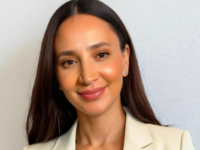Julie Mathers and husband Tom started online business Flora & Fauna as a side hustle while working full-time elsewhere in 2014. Since then, the business has become a leading eCommerce concern that is the couple’s full-time occupation – alongside raising two young children. We spoke to Julie about the challenges and rewards of transforming the purpose-driven side gig into the significant business it has become today.
ISB: What was the inspiration behind Flora & Fauna, and when did you launch the business?
JM: I started Flora & Fauna to make a difference. I have worked in retail for over 25 years and I’ve always had an itch to run my own business and really drive change with how retail is done – I wanted to create a better business. The initial version of Flora & Fauna was a cruelty-free online beauty store; I have long been passionate about animal welfare and I struggled to find truly cruelty-free makeup so I thought I’d launch a business that was transparent so it was easy for customers to shop. We launched in November 2014 with 30 brands and 500 products, all centred around makeup. Our website was pretty bad but was what we needed to get started. At that point, I was the picker, packer, customer-service agent, graphic designer, marketer, buyer, and eCommerce everything. We were bootstrapped from the outset.
ISB: What were the standout challenges and highlights of the start-up phase?
JM: Tom and I loved the start-up phase. It was the most fun bit for us, as it’s all discovery, trial, and a bit of error, and the risk is a lot less, as is the reward, but that’s part of the journey. One of the biggest learnings was to try to be OK with failing. Make calculated decisions but if they don’t work, it’s OK.
One of our first learnings was an expo back in 2015. We were six months in and we had no idea how to run a successful event. It failed dismally; our stand looked terrible and we had all the wrong products and a bad location. We remember that event so vividly and from there on in our events were a success.
“We have been able to define our purpose and use our profit to do good.”
A couple of years in, we started to really grow which was a highlight and challenge at the same time. In two years, we grew 2000 per cent. We needed a bigger team, a bigger warehouse, processes, and a better website. All challenges, but this is where you have to really roll with it, enjoy the ride, and have great people supporting you on your journey.
ISB: I know Flora & Fauna has always been a purpose-driven enterprise – please could you encapsulate that purpose?
JM: Our purpose is to help everyone make better choices. Better choices for our planet, people, and animals. It took us three-four years to really define our purpose. We were doing everything already, we just needed to be able to encapsulate it in a few words. Our purpose is underpinned by eight values and we live and breathe them.
Our purpose and values are our DNA. We think about better choices in everything we do. So product is one area but it’s also our packaging, waste management, banking, super, customer experience, recycling, etc.
We also support likeminded charities, like Where Pigs Fly, Down Syndrome Australia and HeartKids. In 2017, we took our purpose one step further by becoming a certified B Corp. This was a really important step for us to live our purpose and always put it before profit. Since then, we’ve become carbon offset, extended our recycling scheme and really focused on diversity and inclusion. The team talks about values and purpose and holds us to account, which is great, this is when you know it’s bedded into your business.
ISB: And how do you ensure you don’t lose sight of that purpose under the pressure of rapid growth and having to scale the business?
JM: As we’ve grown, we have been able to really lean into our purpose. We understand more about who we are, our reason for being and also who our customers are and what they want. That means we have been able to define our purpose and use our profit to do good. We have extended our recycling scheme, partnered up with charities and also offset our carbon. It was harder to do this when we were smaller, as we didn’t have the funds.
ISB: What is your vision for the growth and development of Flora & Fauna in the next couple of years?
JM: I always think about the industry as a whole. My focus is on more businesses being better businesses. I believe every business should be operating at B Corp standard and I hope that with F&F being a leader here, it inspires others to make small changes. More customers are demanding it.
I now see more eco products in mainstream retailers and this is just the start. I’ve just invested in a platform called Releaseit, which is all about reusing and renting (, rather than buying new. It’s the eBay of rentals. We’ll see more impact-led businesses being launched and we’ll see them get backers and get high multiples, too. We need to start thinking differently about consumerism.
ISB: Finally, you mentioned a few years ago you had done retail well and badly over your journey. You’re evidently doing it well now, so what are the key learnings you’d share with aspiring entrepreneurs looking to start their own retail business?
JM: I’ve seen retail being done well and badly and, over my career, I’ve witnessed errors being made. So I listened, learned, and put those learnings in my tool box. I’m all about my experiences and learnings, the key ones being:
1) Commit or don’t. Flora & Fauna was a side hustle when we started and it grew. We got to the point when it needed our full attention. My husband and I both left full-time jobs to run Flora & Fauna and that was one of the best decisions we made. It was pivotal to our growth.
2) Cash is king and queen. For the first seven years, we were bootstrapped and it is hard but cash is so important. I have seen many businesses fail because they couldn’t pay the bills. We have always been really focused on our cashflow and checked it multiple times a day at times. Be obsessed with it.
3) Chase your own destiny. We know we have competitors, but we focus wholly on our strategy and our plan and we don’t get sidetracked from that. I know retailers who follow their competitors – that is not a strategy.
4) Find your purpose. Figure out who you are, what you are about, and your values. This was an ‘Aha!’ moment for us, when we could really define ourselves. From then, we chased it pedal to the metal.
This article first appeared in issue 35 of the Inside Small Business quarterly magazine
















